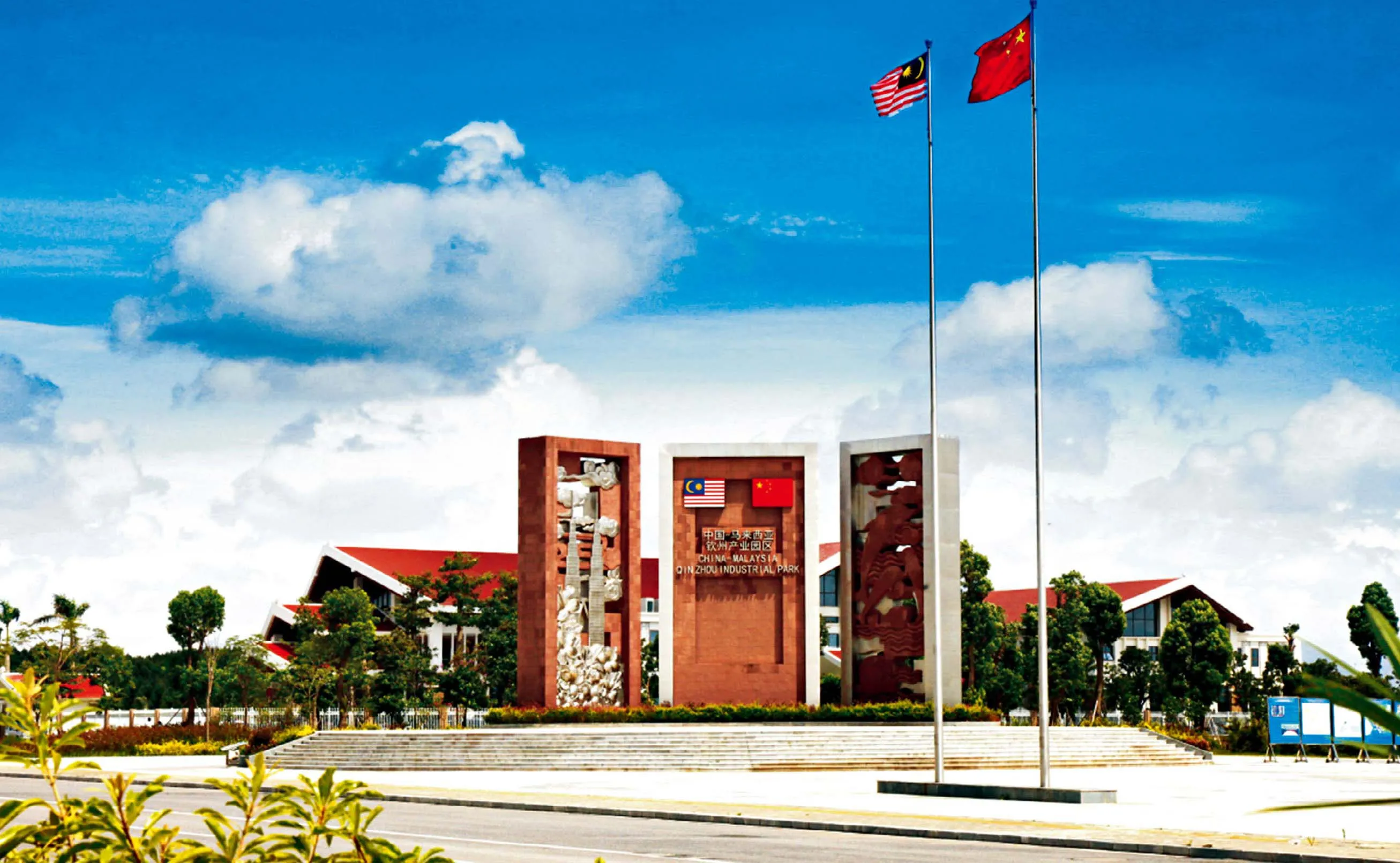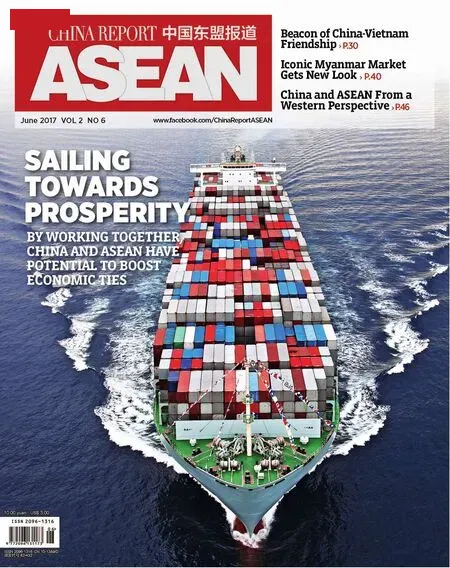ICONIC PROJECTS OF BILATERAL INDUSTRIAL COOPERATION
By Cheng Qun, Shen Yang, Pan Qiang
ICONIC PROJECTS OF BILATERAL INDUSTRIAL COOPERATION
By Cheng Qun, Shen Yang, Pan Qiang
Qinzhou and Kuantan industrial parks allow greater access to respective markets
In Qinzhou, south China's Guangxi Zhuang Autonomous Region, the site of the future China-Malaysia Qinzhou Industrial Park is bustling as construction proceeds. At the same time, equipment at the Malaysia-China Kuantan Industrial Park on the east coast of peninsular Malaysia is being prepared for the companies that are soon to begin operations in the park. At Kuantan, construction of the US$1.4 billion blast furnace of the joint iron and steel works has been nearly completed. The project, with an expected annual capacity of 3.5 million tons of steel, is an iconic project of China-ASEAN production capacity cooperation.
Industrial Parks Boost Trade
The Qinzhou and Kuantan industrial parks are twin national-level projects planned and constructed jointly by the governments of China and Malaysia. Taking full advantage of their close proximity to sea ports, the two industrial parks interact with each other in shipping, trade and industrial development. The Beibu Gulf Port in Guangxi has thus become a major gateway between China and ASEAN.
Guangxi GIG Joy Sense Cable Company plans to operate at the Qinzhou Industrial Park. Its general manager, Zhang Jinglin, said that ASEAN presents broad market opportunities for Chinese companies, and that through the platform provided by the twin industrial parks, his company hopes to conduct close cooperation with a large number of countries along the Belt and Road.
“The twin industrial parks have followed China’s industrial restructuring closely, as well as the upgrading of global economic systems," said Gao Pu, executive deputy director of the administrative committee of Qinzhou Industrial Park. " They both aim to merge into the global industrial value chain."
The twin parks are flagship projects of Belt and Road industrial cooperation, which are mutually complementary in terms of both industrial chain and infrastructure.
The Chinese and Malaysian twin industrial parks serve as a microcosm of overall cooperation that exists between China and ASEAN. As the seventh largest economy in the world with a population of more than 600 million and an economic aggregate of nearly US$3 trillion, ASEAN is a priority area and key region in the construction of the Belt and Road Initiative.

Mutually Beneficial Cooperation
Relations between China and ASEAN have developed from Dialogue Relations to a “Good-Neighborly Partnership of Mutual Trust Oriented Towards the 21st Century” and the “Strategic Partnership for Peace and Prosperity”. Pragmatic exchanges and cooperation between the two sides have never been as close as today. In recent years, China and ASEAN countries have achieved a great deal in terms of trade, production capacity cooperation and cultural and people-to-people exchanges.

Above: The China-Malaysia Qinzhou Industrial Park is likely to be part of the planned Beibu Gulf Free Trade Pilot Zone.

Right: Qinzhou Mayor Li Xinyuan (right) and Kuantan Port Consortium (KPC) chief operating officer Datuk Khasbullah A. Kadir (left) signed an agreement on sister port relations between Qinzhou and Kuantan in Nanning in southern China's Guangxi Zhuang Autonomous Region on Sept. 15, 2014.
Zhao Minglong, a research fellow at the Guangxi Academy of Social Sciences, said that friendly cooperation between China and ASEAN has come a long way. The two parties are bringing their own advantages fully into play in the construction of a Belt and Road demonstration zone. This cooperation not only meets the development needs of both, but also brings tangible benefits to the people of both countries.
In 2016, a contract was signed for the construction of the Jakarta-Bandung High-Speed Railway by PT Kereta Cepat Indonesia (a joint venture), linking the Indonesian capital with the country's third largest city. The project marks the first systematic export of China’s high-speed railway (CRH) technology, which will cover the whole industrial chain with total factor productivity (TFP), a major feat in the implementation of the Belt and Road Initiative.
Indonesia is ASEAN's largest economy. The Jakarta-Bandung Railway will promote bilateral production capacity cooperation and bring convenience to the population living near the rail line. With the quality and speed of Chinese engineering, the railway will greatly improve Indonesia's infrastructure and drive economic development along the route.
ASEAN countries are generally at the primary to intermediate stage of industrialization. The ongoing process of industrialization and urbanization in these countries generates considerable potential for industrial development with urgent demand for equipment, technology and capital, especially in the sectors of electricity, cement, construction machinery and renewable energy.
Zhai Kun, director of the Global Interconnectivity Research Center of Peking University, said that China and ASEAN countries have laid a good foundation for unimpeded trade. With the upgrading of the China-ASEAN Free Trade Area (FTA), bilateral trade relations will become even closer. To accelerate connectivity of policy, transportation, trade, finance and people between China and ASEAN, it is essential to strengthen policy coordination, Zhai said.
China’s imports and exports with other countries along the Belt and Road increased in the first quarter of 2017. A 25 percent increase in imports and exports with ASEAN countries was much higher than average.
The Belt and Road is proving to be an important opportunity for ASEAN. The Asian Infrastructure Investment Bank (AIIB) has been established, and the Lancang-Mekong Cooperation Mechanism (LMC) has been created. Negotiations on upgrading the China-ASEAN FTA have been completed. The Belt and Road Initiative has been aligned with the development strategies of ASEAN countries.
Yang Xiuping, Secretary-General of the ASEAN-China Center, commented that China and ASEAN should seize the opportunities arising from the construction of the Belt and Road Initiative to unleash the potential for greater cooperation across the region.

